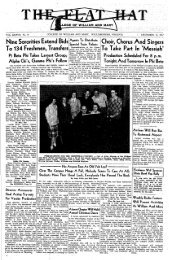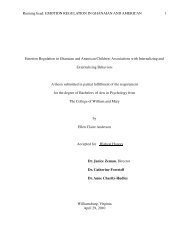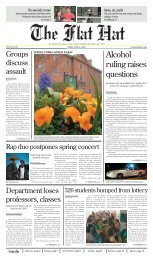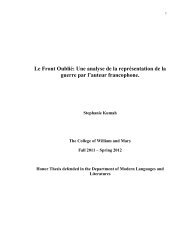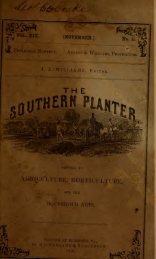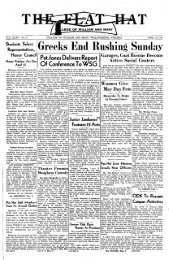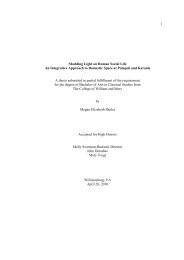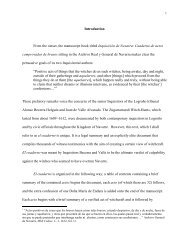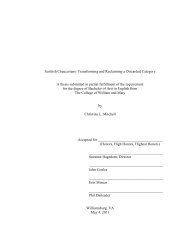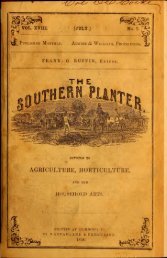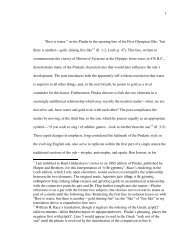Southern planter - The W&M Digital Archive
Southern planter - The W&M Digital Archive
Southern planter - The W&M Digital Archive
You also want an ePaper? Increase the reach of your titles
YUMPU automatically turns print PDFs into web optimized ePapers that Google loves.
1908.] THE SOUTHERN PLANTER. 13<br />
of Virginia should teach agriculture. <strong>The</strong> effort in that<br />
line years ago on the Miller foundation was not encour-<br />
aging. In faot, as a mere University study, agriculture<br />
has seldom been well taught. Far better concentrate on<br />
the Virginia Polytechnic Institute. <strong>The</strong> University is a<br />
great institution, with a noble history, but it is not big<br />
enough to teach agriculture as it is demanded at this<br />
present day. <strong>The</strong> Miller Fund in the University is doing<br />
more good as a Department of Biology than it ever could<br />
do in agriculture.<br />
Tomatoes Under Glass.<br />
<strong>The</strong> Editor is perfectly right in telling Mr. Cox, of Nor-<br />
folk county, that tomatoes cannot be grown successfully<br />
in a cold pit. <strong>The</strong>y might be wintered over in such a<br />
structure and be considerably earlier in late spring than<br />
the outside crop, but to ripen tomatoes during the winter<br />
requires artificial heat other than the mere sun heat under<br />
glass. <strong>The</strong> temperature at night should never be under<br />
60 degrees and a good deal higher in daytime, and while<br />
the unheated structure might get as warm as needed when<br />
the sun shone, it would be entirely too cold in dark weather<br />
and at night. In Eastern Virginia the forcing of tomatoes<br />
in greenhouses can be done more cheaply than in the<br />
North, owing to the abounding sunshine in winter and the<br />
absence of the long, dark spells common on the Northern<br />
Atlantic coast. For this reason, less fuel will be needed.<br />
But the man who undertakes tomato forcing in winter in<br />
any make-shift house will find that his experience has cost<br />
him a good deal. In fact, wirter forcing under glass calls<br />
for a high degree of skill on the part of the gardener.<br />
But in the South Atlantic coast country the tendency is<br />
in that direction. <strong>The</strong> use of steam in the cloth-covered<br />
lettuce frames in North Carolina is one step towards real<br />
winter work. Horticultural work is rapidly cut up into<br />
specialties, and one man does not attempt to grow every-<br />
thing. I met only last week a man who has five acres<br />
covered with glass in heated greenhouses, and his main<br />
business is the production of young plants for other<br />
gardeners to set. He told me that he sowed last season<br />
nine bushels of pepper seed alone and cabbage and tomato<br />
and other seed by the cartload.<br />
In one large establishment near Philadelphia there are<br />
acres of glass, and all used for the production of palms<br />
and ferns.<br />
In New England there are numerous places where the<br />
sole business is the production of cucumbers in winter,<br />
and these, as well as tomatoes, can be more economically<br />
grown in the upper South. But the man must know how<br />
and must have a modern equipment for the business.<br />
Corn on High Land.<br />
<strong>The</strong> Editor advises "Subscriber" right in regard to corn<br />
for high land. I met a large farmer a few days ago who<br />
told me that he had planted the finest ears of corn he<br />
ever saw, and was not satisfied with the yield he got.<br />
From his description of the corn, I found that he planted<br />
the big-eared Gourd-seed or horse-tooth corn—a type only<br />
suited to moist lowland and very rich soil, while his land<br />
was sandy upland.<br />
A farmer, going to one of the corn shows and selecting<br />
the big ears for seed, would probably be disappointed in<br />
the yield if he planted the seed on ordinary dry upland.<br />
I would advise "Subscriber" to get the best corn grown<br />
on upland that he can find in his neighborhood and not to<br />
send off and get some he will have to acclimate. <strong>The</strong>n<br />
breed it for yourself.<br />
Nut Grass.<br />
<strong>The</strong> most efficient exterminator of nut grass is a flock<br />
of geese kept on it all the season to prevent its seeding<br />
and to keep the tops nipped off continually. <strong>The</strong>re are<br />
a hundred plants of nut grass that come from seed to<br />
every one that is produced from the tubers. If the tops<br />
are continually nipped off, as the geese will nip them,<br />
the plant will give up the effort and the hogs can finish<br />
the roots. w. F. MASSEY.<br />
CROP ROTATION—LIME—FARM<br />
Editor <strong>Southern</strong> Planter:<br />
HORSES—TIMBER<br />
In the December issue of your most valuable Journal<br />
Mr. Hicks criticizes the crop rotation suggested in a pre-<br />
vious issue by Mr. Coleman and asks for further discussion<br />
of the subject. At Bullfield a four-field rotation was begun<br />
this year, and is given below, together/ with the rotations<br />
used by Mr. Coleman and Mr. Hicks:<br />
1<br />
FIELD I. FIELD II. FIELD III. FIELD IV.<br />
Coleman. Oats and Vetch Cow Peas and<br />
Crimson<br />
Clover<br />
Hicks.<br />
Bullfield.<br />
Crimson<br />
Clover for Corn<br />
Corn with<br />
Crimson<br />
Clover<br />
Peas followed<br />
by Oats<br />
Crimson<br />
Clover followed<br />
by Oats<br />
Crimson<br />
Clover for<br />
Corn<br />
Oats followed<br />
by Crimson<br />
Clover<br />
Oats Harvest Red and Alsike<br />
Clover<br />
At Bullfield the crimson clover is seeded between the<br />
corn rows with a combination weeder and seeder. <strong>The</strong><br />
red and alsike clovers are seeded with the oats, together<br />
with 300 pounds of phosphate and 100 pounds of bone,<br />
followed later by a top dressing of stable manure at the<br />
rate of three loads per acre. This year the seeder arrived<br />
too late for using it in the corn and the seed was scattered<br />
on the ground before rains. Where the crimson<br />
clover fails, or where the seed could not be put in on<br />
time, the corn stubble is disked and seeded to thirty pounds<br />
of vetch, one-half bushel of oats, and one-quarter bushel<br />
of wheat, together with 300 pounds of phosphate. <strong>The</strong><br />
vetch is intended for hay. <strong>The</strong> corn is cultivated flat with<br />
riding disk cultivators and the crimson clover might also<br />
be harvested for hay if we could get rid of the corn<br />
stubble.<br />
This rotation permits of clean summer fallowing the<br />
second year (between the crimson clover and the oat<br />
crops), or green fallowing by sowing cow peas or cow<br />
peas with millet for hay, if other work permits ploughing<br />
early enough.<br />
<strong>The</strong> rotation used by Mr. Hicks is perhaps subject to<br />
the criticism that it leaves the corn stubble land bare all<br />
winter, which is undesirable.<br />
<strong>The</strong> most difficult part about liming the land seems to<br />
be the getting of the lime at a reasonable price. Agri-<br />
cultural lime is offered by one kiln advertising in the<br />
October issue of th© <strong>Southern</strong> Planter at $1.50 per ton,



